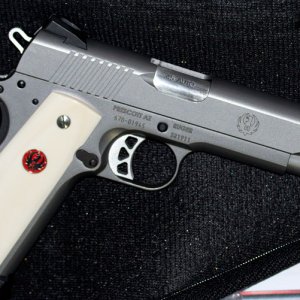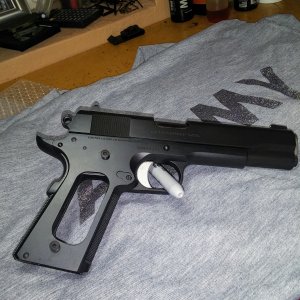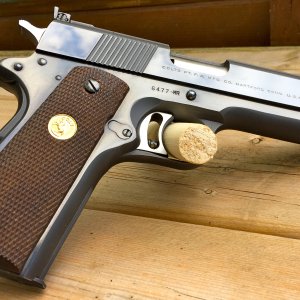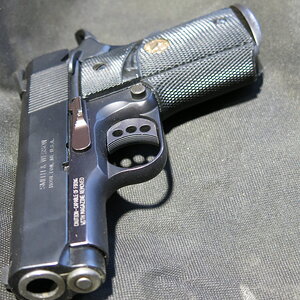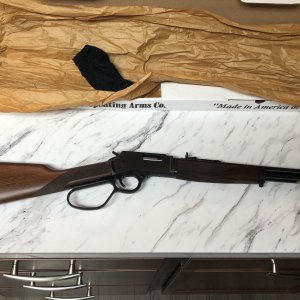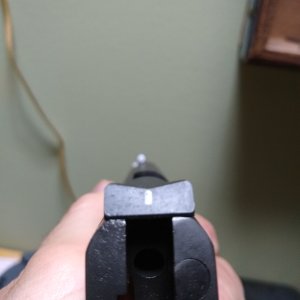bigbrowndog
Red Neck Tactical
Everybody seems to remember certain stages or favorite parts of stages or least favorite parts of stages.
What makes up a stage? You have a brief descriptive overview, a start position, a descriptive list of
requirements, some props, targets, round count, and scoring method. It sounds easy enough, heck any
yahoo with a brain, a bay, and a pencil can design a stage. A good stage will be one that challenges
everyone either by taking them out of their comfort zone or by giving them a false sense of ease about
the stage. A good stage will have subtle changes in it or can appear very similar to another stage but
with more or less challenge to it. Stages should never be HARD!!! I have heard MD’s apologize to
competitors for stages, saying “I’m sorry, that was a very hard stageâ€â€¦â€¦..What were you thinking!!!!
Every prepared competitor you expect at your match should be able to complete every stage. If you
have more than 30% of your total competitors timeout on a stage, you have yourself to blame. When
stages are designed, especially any with long range rifle targets, they should be looked at from a
“C†class or limited experience perspective, even better would be to add an iron sights or a 1x optic
perspective into the mix. Have your stages shot in by average “C†class shooters, before the RO’s shoot
for score otherwise it’s too late. An example of verifying a realistically placed target or stage is that for
IPSC practical shotgun matches all target presentations are shot using a cylinder bore shotgun, thereby
allowing the MD to know that the target is able to be hit with all chokes. The better shooters will
challenge each other with speed, but all will be challenged and all will be able to complete the COF, and
all will walk off the stage with a sense of accomplishment instead of dismay and disgust. Stages should
be designed simple, it’s much easier to keep a simple stage up and running throughout the match and
keep it flowing with little to no down time. Simple does not mean easy, take 8 rifle targets, 4 moa in
size and place them from 75 yds. to 200 yds. with no prone or artificially supported position available
and it easily becomes a 30 round COF, for the average competitor. By keeping stages simple they can
be run fairly and as all weather neutral as possible, just because you have access to acres and acres of
terrain or bays does not mean that you can set common sense aside, and have elaborate and complex
stages and still expect to everything to run smoothly and on time. Stages need to be set up around an
idea or design and then built into a final stage. Proper Planning Prevents Poor Performance, do not
throw targets into an area or bay with no idea or sketch to work from and then produce a stage
description from that, that is lazy and shows a lack of respect for your paid competitors, they will
notice. Target placement, shooters pathways, and shooting positions need to be considered doable and
fair in all weather conditions or be prepared to throw out stages due to lack of fairness and consistency.
Hiking in 4 miles around a mountain, canyon or creek to put up a target on a hillside may sound cool, but
getting back to that target to replace , repair, paint, or other reason is foolish and time consuming. On
the subject of painting targets, a good match with good stages, RO’s and MD/RM will as a MINIMUM,
paint all steel targets for every squad, and no shoot steel shotgun targets should be painted whenever
they are hit. This is easily accomplished by locating your steel in areas that are easy to get to (where
have I heard that before) and by utilizing any mode of transportation you can get, ATV’s, golf carts,
cars, trucks, bikes, horses, whatever………..or by positioning someone safely downrange and
coordinating their movement by radio. I have not been to a 3 gun/ multigun match that did not have at
least one of these options available and yet rarely is it ever done. I was told that a certain MD/RM was
suddenly and regrettably placed in a position to experience firsthand how humiliating it can be to be
shooting a match with iron sights and not be able to see the long range targets, hopefully the
experience will enlighten them to its importance. It is one thing to know where your target is, it is
another to be able to see it. Another aspect that seems to be uniquely 3 gun, is the use of more and
more prop guns. I think I get the general idea, sponsors want their toys introduced to shooters, or
a MD/RM wants to add an “exotic flair†to a stage. Somewhere back there I said, a good stage is
designed to be simple. Having a prop gun in a stage instantly makes a simple stage a prospect for being
thrown out. If the prop is from a match sponsor, then asking a competitor to shoot it and enjoy and
appreciate it on the clock is ridiculous, also asking the competitor to be gentle with it while on the clock,
is ridiculous, if you want to showcase a prop gun at a stage, do it off the clock and allot time for the
demoing of the gun. If you as a MD are not willing to do that then why should the competitor care for
your concerns. If you simply want to add an exotic flair to a stage, then do it off the clock and start the
stage when the competitor is finished ogling your exotic flair.
stage descriptions,......... next
What makes up a stage? You have a brief descriptive overview, a start position, a descriptive list of
requirements, some props, targets, round count, and scoring method. It sounds easy enough, heck any
yahoo with a brain, a bay, and a pencil can design a stage. A good stage will be one that challenges
everyone either by taking them out of their comfort zone or by giving them a false sense of ease about
the stage. A good stage will have subtle changes in it or can appear very similar to another stage but
with more or less challenge to it. Stages should never be HARD!!! I have heard MD’s apologize to
competitors for stages, saying “I’m sorry, that was a very hard stageâ€â€¦â€¦..What were you thinking!!!!
Every prepared competitor you expect at your match should be able to complete every stage. If you
have more than 30% of your total competitors timeout on a stage, you have yourself to blame. When
stages are designed, especially any with long range rifle targets, they should be looked at from a
“C†class or limited experience perspective, even better would be to add an iron sights or a 1x optic
perspective into the mix. Have your stages shot in by average “C†class shooters, before the RO’s shoot
for score otherwise it’s too late. An example of verifying a realistically placed target or stage is that for
IPSC practical shotgun matches all target presentations are shot using a cylinder bore shotgun, thereby
allowing the MD to know that the target is able to be hit with all chokes. The better shooters will
challenge each other with speed, but all will be challenged and all will be able to complete the COF, and
all will walk off the stage with a sense of accomplishment instead of dismay and disgust. Stages should
be designed simple, it’s much easier to keep a simple stage up and running throughout the match and
keep it flowing with little to no down time. Simple does not mean easy, take 8 rifle targets, 4 moa in
size and place them from 75 yds. to 200 yds. with no prone or artificially supported position available
and it easily becomes a 30 round COF, for the average competitor. By keeping stages simple they can
be run fairly and as all weather neutral as possible, just because you have access to acres and acres of
terrain or bays does not mean that you can set common sense aside, and have elaborate and complex
stages and still expect to everything to run smoothly and on time. Stages need to be set up around an
idea or design and then built into a final stage. Proper Planning Prevents Poor Performance, do not
throw targets into an area or bay with no idea or sketch to work from and then produce a stage
description from that, that is lazy and shows a lack of respect for your paid competitors, they will
notice. Target placement, shooters pathways, and shooting positions need to be considered doable and
fair in all weather conditions or be prepared to throw out stages due to lack of fairness and consistency.
Hiking in 4 miles around a mountain, canyon or creek to put up a target on a hillside may sound cool, but
getting back to that target to replace , repair, paint, or other reason is foolish and time consuming. On
the subject of painting targets, a good match with good stages, RO’s and MD/RM will as a MINIMUM,
paint all steel targets for every squad, and no shoot steel shotgun targets should be painted whenever
they are hit. This is easily accomplished by locating your steel in areas that are easy to get to (where
have I heard that before) and by utilizing any mode of transportation you can get, ATV’s, golf carts,
cars, trucks, bikes, horses, whatever………..or by positioning someone safely downrange and
coordinating their movement by radio. I have not been to a 3 gun/ multigun match that did not have at
least one of these options available and yet rarely is it ever done. I was told that a certain MD/RM was
suddenly and regrettably placed in a position to experience firsthand how humiliating it can be to be
shooting a match with iron sights and not be able to see the long range targets, hopefully the
experience will enlighten them to its importance. It is one thing to know where your target is, it is
another to be able to see it. Another aspect that seems to be uniquely 3 gun, is the use of more and
more prop guns. I think I get the general idea, sponsors want their toys introduced to shooters, or
a MD/RM wants to add an “exotic flair†to a stage. Somewhere back there I said, a good stage is
designed to be simple. Having a prop gun in a stage instantly makes a simple stage a prospect for being
thrown out. If the prop is from a match sponsor, then asking a competitor to shoot it and enjoy and
appreciate it on the clock is ridiculous, also asking the competitor to be gentle with it while on the clock,
is ridiculous, if you want to showcase a prop gun at a stage, do it off the clock and allot time for the
demoing of the gun. If you as a MD are not willing to do that then why should the competitor care for
your concerns. If you simply want to add an exotic flair to a stage, then do it off the clock and start the
stage when the competitor is finished ogling your exotic flair.
stage descriptions,......... next


